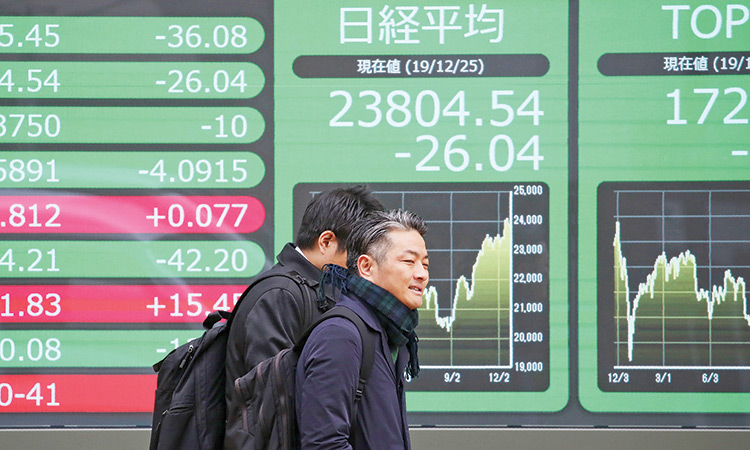Asian markets subdued ahead of BoJ meeting, US inflation report

Picture used for illustrative purpose only.
The Bank of Japan (BOJ) meets Tuesday amid much chatter that it is considering how and when to move away from negative interest rates. None of the analysts polled by Reuters expected a definitive move at this meeting, but policy makers might start laying the groundwork for an eventual shift.
April was favoured by 17 of 28 economists as the kick-off for negative rates to be scrapped, making the BOJ one of the few central banks in the world actually tightening.
“Since the last meeting in October, 10-year JGB yields have fallen and the yen has appreciated, giving the BOJ little incentive to revise policy at this stage,” said Barclays economist Christian Keller.
“We think the BOJ will wait to confirm the result of the ‘shunto’ wage negotiations next spring, before moving in April.” Japan’s Nikkei lost 0.7%, weighed in part by a firm yen. MSCI’s broadest index of Asia-Pacific shares outside Japan dipped 0.3%.
South Korea’s main index added 0.3%, showing no obvious reaction to reports North Korea had fired a ballistic missile off its east coast.
Chinese blue chips edged down 0.3%, following five straight weeks of falls.
S&P 500 futures inched up 0.3%, while Nasdaq futures added 0.2%. EUROSTOXX 50 futures slipped 0.3% and FTSE futures 0.1%.
Over in the United States, a reading on core personal consumption expenditure (PCE) index is forecast by analysts to rise 0.2% in November with the annual inflation rate slowing to its lowest since mid-2021 at 3.4%.
Analysts suspect the balance of risk is on the downside and a rise of 0.1% for the month would see the six-month annualised pace of inflation slow to just 2.1% and almost at the Federal Reserve’s target of 2%.
Markets reckon the slowdown in inflation means the Fed will have to ease policy just to stop real rates from rising, and are wagering on early and aggressive action.
New York Fed President John Williams did try to rain on the parade on Friday by saying there was no talk of easing by policy makers, but markets were disinclined to listen.
Two-year Treasury yields ticked up only slightly in response, and still ended the week down a steep 28 basis points at the lowest close since mid-May.
Yields on 10-year notes stood at 3.91%, having dived 33 basis points last week in the biggest weekly fall since early 2020.
Fed fund futures imply a 74% chance of a rate cut as early as March, while May has 39 basis points (bp) of easing priced in. The market also implies at least 140 basis points of cuts for all of 2024.
“We now forecast three consecutive 25bp cuts in March, May, and June, followed by a slower pace of one cut per quarter until reaching a terminal rate of 3.25-3.5%, 25bp lower than we previously expected,” wrote analysts at Goldman Sachs in a client note.
“This implies five cuts in 2024 and three more cuts in 2025.” If correct, such easing would allow some Asian central banks to ease earlier, with Goldman bringing forward cuts in India, Taiwan, Indonesia and the Philippines.
The investment bank also raised its forecast for the S&P 500 which it now sees ending 2024 at 5,100, while decelerating inflation and Fed easing would keep real yields low and support a price-to-earnings multiple greater than 19.
The market’s dovish outlook for US rates saw the dollar slip 1.3% against a basket of currencies last week, though the Fed is hardly alone in the rate-cutting stakes.
Markets imply around 150 basis points of easing by the European Central Bank next year, and 113 basis points of cuts from the Bank of England.
That outlook restrained the euro at $1.0909, having pulled back from a top of $1.1004 on Friday. The dollar was looking more vulnerable against the yen at 142.23, having slid 1.9% last week.
The drop in the dollar and yields should be positive for gold at $2,021 an ounce, though that was short of its recent all-time peak of $2,135.40.
Oil prices were trying to steady after hitting a five-month low last week amid doubts all OPEC+ producers will stick with caps on output.
Lower exports from Russia and attacks by the Houthis on ships in the Red Sea offered some support. Brent nudged up 47 cents to $77.02 a barrel, while US crude rose 47 cents to $71.90.
Separately, Goldman Sachs raised its 2024 S&P 500 target by 8% to 5,100, forecasting a tailwind for US stocks from falling inflation and declining interest rates.
Unlike 2023, when the so-called Magnificent Seven group of mega-cap growth and technology stocks have powered the majority of the year’s advance in the S&P 500, the upcoming gains in the stock market will come from cyclical sectors and companies with smaller market capitalization, Goldman said in a note late on Friday.
“Looking forward, the new regime of both improving growth and falling rates should support stocks with weaker balance sheets, particularly those that are sensitive to economic growth,” the firm wrote.
Agencies







